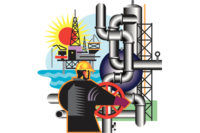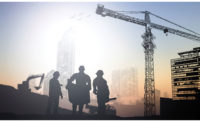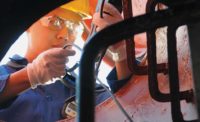Improper confined space ventilation is a top cause of workplace injury and death. Safety managers and personnel must provide properly ventilated spaces to safeguard their workers' well-being.
What is a confined space?
In industrial and construction sectors, a confined space is a relatively small, enclosed area. It typically restricts movement and limits visibility, posing a risk to workers. According to the Occupational Safety and Health Administration (OSHA), a confined space:
Must be large enough for a worker. They need enough room to enter and do their job.
Is only designed for temporary occupancy. The spaces are not technically designed for humans to enter. Also, remaining inside them for extended periods is usually unsafe.
Has limited entry and exit points. Interiors with large openings or many entrances do not count as confined.
Under OSHA’s definition, the interior of grain silos, septic tanks, dumpsters, tunnels and petroleum tanks are examples of confined spaces. Other common kinds are manure pits, crawl spaces, wells, trenches and ductwork.
Safety personnel responsibilities for confined spaces
Above all else, safety personnel must educate workers to ensure their well-being. They need to enforce specialized OSHA training before allowing entry into potentially dangerous confined spaces. Whether they know of a preexisting hazard or become aware of one, they have to inform everyone of the risks. The same process applies if employees display a lack of understanding of protocol.
During workers’ occupancy in the confined space, safety personnel must ensure they are not at risk of injury, illness or death. For instance, they must enforce OSHA’s exposure limits to minimize airborne hazards. Confirming confined space ventilation is adequate — meaning it doesn’t put people’s health at risk while they work — is critical at this stage.
Monitoring everyone’s physical health is just as essential as hazard identification because it can expose earlier oversights or unexpected changes. Even if safety personnel don’t initially detect confined space ventilation threats, they can appear suddenly. For example, hydrogen sulfide — also known as sewer or swamp gas — naturally occurs in spaces like cisterns, oil wells, sewers and manure pits.
If workers complain about hazards or refuse to enter the confined space, safety managers must immediately take action. They can only allow people to enter once they have identified, assessed and eliminated the present risks. Afterward, monitoring and routine maintenance are crucial.
Why are properly ventilated spaces vital?
Poor ventilation is one of the leading causes of workplace accidents and fatalities. According to one study, it accounts for 27% of on-site injuries in confined spaces. Naturally, it should be among safety managers' top priorities.
Properly ventilated spaces are of the utmost importance. For workers to remain safe, safety personnel must perform hazard identification and thorough risk assessments. Additionally, they must adequately train people according to OSHA's guidelines.
The risks of improper confined space ventilation
Poor ventilation in tight spaces can increase temperatures, impact oxygen levels and cause harmful airborne substance buildup. As a result, workers can suffer severe injuries, illnesses and even death. If safety personnel don't take proper precautions, a single incident could take multiple lives. Explore the outcomes of these common risks.
Heat and humidity buildup
Although heat- and humidity-related illnesses may not seem as severe as harmful substance inhalation or oxygen deficiencies, they can be just as deadly. Improper confined space ventilation quickly leads to temperature spikes, resulting in discomfort, heat exhaustion and heat stroke.
In some cases, heat and high humidity can increase airborne pollutant levels, which poses a further risk to workers. Crucially, the effects — respiratory diseases and cancer — may not show up until years of repeated exposure and can prove fatal.
Heat- and humidity-related issues are more common in above-ground interiors. Notably, metal structures like grain silos and oil tanks are better at conducting heat. Safety personnel should ensure workers have properly ventilated spaces to cool off while performing their duties.
Oxygen enrichment
Oxygen only makes up 21% of the atmosphere, while nitrogen, argon and other trace gases account for the rest. Although enrichment — where the oxygen level exceeds 21% — is safe in controlled environments, it is a hazard in confined spaces. Left unchecked, it can cause fires and explosions that burn much faster and hotter than usual.
Common causes of enrichment include faulty pipe connections, oxygen leaks and specific chemical reactions. Safety personnel must properly inspect the site and gas levels to eliminate these sources.
Oxygen deficiency
If the amount of oxygen in a space drops significantly below 21%, workers can experience dizziness, shortness of breath, unconsciousness, cardiac arrest and suffocation. A lack of breathable air quickly leads to death.
Oxygen deficiencies come from improper airflow. If confined space ventilation is poor, workers use more breathable air than what naturally filters in. Safety professionals can prevent this situation by monitoring gas levels or providing personal protection equipment.
Airborne chemicals
Fumes, airborne particles and an accumulation of gases present serious hazards to worker health. According to the Bureau of Labor Statistics, confined spaces brought about 1,030 fatalities between 2011 and 2018, with harmful substance inhalation being the leading cause of death. When not fatal, it can cause respiratory issues and severe illness.
Many airborne substances are life-threatening in high concentrations. While they can rapidly build up naturally, artificial sources like pipe faults, cleaning solvents and certain chemical reactions can also produce them.
Safety personnel must ensure workers have properly ventilated spaces to prevent harmful substance inhalation. They can take proactive measures like gas-level monitoring to prevent hazardous buildup.
Airborne pollutants
Hazardous airborne pollutants include fibers, dust, fumes and debris. Even though concrete dust and welding fumes are not typically dangerous, they become so in confined spaces.
Hazardous pollutants build up much slower in properly ventilated spaces. Since safety personnel can’t guarantee adequate ventilation, they must do their best to provide workers with proper PPE and monitor air pollution levels.
The importance of properly ventilated spaces
Management must ensure workers enter properly ventilated spaces before continuing work. Considering the risks include chronic illness and fatality, conducting hazard identification and eliminating safety threats is of the utmost importance.




